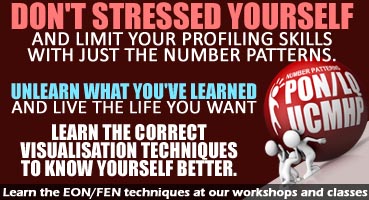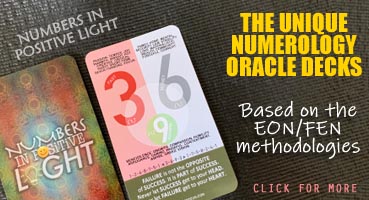Profiling Lessons: Right Course of Action
I was taking a breather and decided to write something different in today’s article.
I’ve self-published my book “Elements of Numbers: Fast and Easy Character Profiling” and conducted courses, workshops, and preview sessions. Through the years, I have received comments from students comparing my EON/FEN/NSQ teaching methods with other trainers from previous courses they’ve completed.
 Since I was updating the slides for the FEN/NSQ course preview session, I thought I could share my observations on the current teaching methods taught by various trainers and tips on selecting the course to suit your profiling interests and needs.
Since I was updating the slides for the FEN/NSQ course preview session, I thought I could share my observations on the current teaching methods taught by various trainers and tips on selecting the course to suit your profiling interests and needs.
There are similarities in the basic theories in the Elements of Numbers (EON) with some other methods conducted by other organisations. However, its similarities end at the basic layers. Beyond that preliminary level, there are huge differences that make each course appealing to different people. There is no CORRECT or WRONG, or GOOD or BAD methods as it depends on the student’s needs and expectations. So, read this article with an open mind.
I’ve grouped the different teaching methods into 4 teaching styles.
 CONFRIMED AFFIRMATIVES (Teaching Method 1). Your trainer only provide ‘no-nonsense’ answers associated to specific numbers and series of numbers at close proximity. You will then associated these series of numbers as ‘number patterns’. And like the chemistry lessons taught at schools, you’re only taught the resulting traits when certain numbers are present. Like the red arrow pointing straight from the entrance to the exit in the picture, you’ll get ‘don’t ask why’ and direct answers in class. Great if you like ‘no brainer’ analysing learning experience. You can generalise this to ‘kindergarten’ (A for Apple, B for Boy…) learning approach. This learning style is great if you just want ‘model answer sheets’ as factual reference for assertive profiling analysis.
CONFRIMED AFFIRMATIVES (Teaching Method 1). Your trainer only provide ‘no-nonsense’ answers associated to specific numbers and series of numbers at close proximity. You will then associated these series of numbers as ‘number patterns’. And like the chemistry lessons taught at schools, you’re only taught the resulting traits when certain numbers are present. Like the red arrow pointing straight from the entrance to the exit in the picture, you’ll get ‘don’t ask why’ and direct answers in class. Great if you like ‘no brainer’ analysing learning experience. You can generalise this to ‘kindergarten’ (A for Apple, B for Boy…) learning approach. This learning style is great if you just want ‘model answer sheets’ as factual reference for assertive profiling analysis.
 AMAZING FLAT PATTERNS (Teaching Method 2). Your trainer will share more traits based on their knowledge of numbers and their Western profiling experiences. You might get to learn many interesting associations and traits beyond Teaching Method 1 above. And there are times your trainer might include expanded chart with extra signs. You’ll also get extra “model answer sheets” type through the chemistry-like teaching lessons. This learning style is great if you need to widen your profiling scope beyond numbers and into human character and behavioural profiling. Like the green arrow pointing around the maze, you might get more possibilities, intense, ‘what ifs’ maze-like conditional answers. Great when you can use both your “left brain” and “right brain” to think, and you know your “left brain” often work better and faster than your “right brain”. You can generalise this to ‘primary school’ (1+1 = 2, 4/2 = 2) learning approach. This learning style is great if you just want ‘multiple-choice questions (MCQ) model answer sheets’ as factual reference to better profiling analysis with extra ‘Oomph”.
AMAZING FLAT PATTERNS (Teaching Method 2). Your trainer will share more traits based on their knowledge of numbers and their Western profiling experiences. You might get to learn many interesting associations and traits beyond Teaching Method 1 above. And there are times your trainer might include expanded chart with extra signs. You’ll also get extra “model answer sheets” type through the chemistry-like teaching lessons. This learning style is great if you need to widen your profiling scope beyond numbers and into human character and behavioural profiling. Like the green arrow pointing around the maze, you might get more possibilities, intense, ‘what ifs’ maze-like conditional answers. Great when you can use both your “left brain” and “right brain” to think, and you know your “left brain” often work better and faster than your “right brain”. You can generalise this to ‘primary school’ (1+1 = 2, 4/2 = 2) learning approach. This learning style is great if you just want ‘multiple-choice questions (MCQ) model answer sheets’ as factual reference to better profiling analysis with extra ‘Oomph”.
 MACROVIEW DIRECT OUTLOOK (Teaching Method 3). Your trainer will provide clues to help you view direct outlook from another perspective. You will get more “translated model answer sheets” to help you gain more profiling knowledge. Like the orange arrow pointing towards one direction only and the availability for you to use other arrows pointing elsewhere, you might get immediate and narrowed directions on a person’s outlook. Great when you are a ‘left brain’ person with ‘clear and direct’ analytical attitude. You can generalise this to ‘secondary school’ (3ax-1=4, binary 1+1 = 10) learning approach. You might benefit from learning style if you prefer academic-inclined and chemistry-like teachings.
MACROVIEW DIRECT OUTLOOK (Teaching Method 3). Your trainer will provide clues to help you view direct outlook from another perspective. You will get more “translated model answer sheets” to help you gain more profiling knowledge. Like the orange arrow pointing towards one direction only and the availability for you to use other arrows pointing elsewhere, you might get immediate and narrowed directions on a person’s outlook. Great when you are a ‘left brain’ person with ‘clear and direct’ analytical attitude. You can generalise this to ‘secondary school’ (3ax-1=4, binary 1+1 = 10) learning approach. You might benefit from learning style if you prefer academic-inclined and chemistry-like teachings.
 VISUALISE MACRO ANALYSIS (Teaching Method 4). Your trainer will share his experience and knowledge to you through visual techniques. This approach empower you to unleash your talent and observations through ‘flashcards’ learning experience. Like the blue arrow moving across and upwards allowing you to have a skyline view, you might get to analyse a person from X, Y, and Z axis directions. This method needs you to use both your left brain (logical) and right brain (creative). This learning style is not for you if you want ‘model answers’ to substantiate and build your profiling knowledge. This method is useful if you want to inculcate the curiosity and inquisitive habits to understand the complexity of tendency signs at past, present, and future times. You’re just like an eagle flying up and observing (analysing) the ground before zooming in on your focused answer when needed. You can generalise this to ‘university or adult-education’ (mind-mapping, process flowcharts) learning approach. You can benefit from this learning style if you like to analyse from multilayer approach through 360-degree perspectives.
VISUALISE MACRO ANALYSIS (Teaching Method 4). Your trainer will share his experience and knowledge to you through visual techniques. This approach empower you to unleash your talent and observations through ‘flashcards’ learning experience. Like the blue arrow moving across and upwards allowing you to have a skyline view, you might get to analyse a person from X, Y, and Z axis directions. This method needs you to use both your left brain (logical) and right brain (creative). This learning style is not for you if you want ‘model answers’ to substantiate and build your profiling knowledge. This method is useful if you want to inculcate the curiosity and inquisitive habits to understand the complexity of tendency signs at past, present, and future times. You’re just like an eagle flying up and observing (analysing) the ground before zooming in on your focused answer when needed. You can generalise this to ‘university or adult-education’ (mind-mapping, process flowcharts) learning approach. You can benefit from this learning style if you like to analyse from multilayer approach through 360-degree perspectives.
 Profiling a person is a complex process and is more than just identifying number patterns and knowing its associated traits and characteristics. We’re all influenced by the periodic energies (coming from the Year, Month, Day, and Seasons), the environment (at work, at home, outside), social (Internet, friends, chat groups) and family values (parents’ upbringing, moral values, education). As the energies (associated to the numbers) are transitional and moves transiently, it affected the chemistry structure of our mood swings, tempers, emotions, thinking, feelings, mental, health, behaviours, beliefs, actions, and well-being.
Profiling a person is a complex process and is more than just identifying number patterns and knowing its associated traits and characteristics. We’re all influenced by the periodic energies (coming from the Year, Month, Day, and Seasons), the environment (at work, at home, outside), social (Internet, friends, chat groups) and family values (parents’ upbringing, moral values, education). As the energies (associated to the numbers) are transitional and moves transiently, it affected the chemistry structure of our mood swings, tempers, emotions, thinking, feelings, mental, health, behaviours, beliefs, actions, and well-being.
Even though twins have identical DNA, their behaviours, thoughts, and actions might be different because of external influences at home, at work, food preferences, time of birth energies, and living lifestyle. Therefore it is important to understand affirmative behavioural trend is good in theory. But these trends might not be practicable in today’s life profiling analysis.
Once you have identified your preferred teaching style and learning approach, the next step is to check the trainer’s fundamental knowledge and research sharing capacity. An experienced trainer or researcher has inculcate the habit to document their findings. If the trainer or researcher has published a book, it imply there is much research and “dedicated work” done earlier especially when their books are also available at local major bookstores. Some authors designed their books like product reference material while others published their books as self-help educational materials. Check if you have benefited after reading their book. The next logical step to check if the trainer’s commitment and passion to impart their knowledge and experience through continual learning. Check if you receive their replies via emails or can read regular article postings on their web sites.
 Make sure your hard-earned money is well-spent on the courses you’ve selected. Expensive courses don’t always imply good quality training, and affordable courses doesn’t always imply inferior or lower quality training.
Make sure your hard-earned money is well-spent on the courses you’ve selected. Expensive courses don’t always imply good quality training, and affordable courses doesn’t always imply inferior or lower quality training.
Check this link to know more on FEN/NSQ course details and schedules.
Make the right choice and understand yourself better. Act decisively and have fun learning.
Happy digesting…
Regards, Ron WZ Sun




 AMAZING FLAT PATTERNS
AMAZING FLAT PATTERNS














